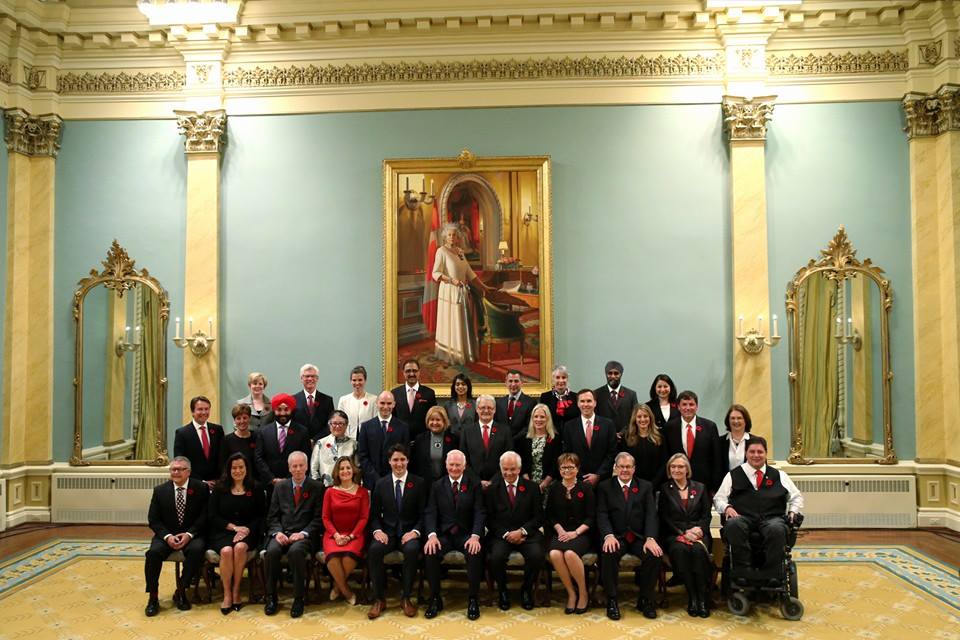
(Photo from the Liberty Party’s official Facebook page)
OTTAWA – Justin Trudeau kicked off a new Liberal era Wednesday with a 30-member cabinet that features predominantly fresh faces, an equal number of men and women and probably the most diverse line-up of ministers in Canadian history.
The newly minted prime minister emerged Wednesday from the formal swearing-in ceremony boasting that he’s put together a cabinet “that looks like Canada.”
Fully 18 of the newly minted ministers are rookies who won election for the first time last month, including the all-important finance minister, multimillionaire Toronto businessman Bill Morneau.
The cabinet includes two aboriginal ministers, two disabled ministers, one openly gay minister, a refugee from Afghanistan and four Sikhs – one of whom was once wrongly accused of terrorism, tortured and detained without trial for almost two years in India.
“The diversity that is reflected around the cabinet table and in the House of Commons is incredibly empowering,” said Jody Wilson-Raybould, Canada’s first indigenous justice minister.
“(It) brings new voices to the table for substantive discussions and debate and dialogue and different perspectives from backgrounds but ultimately working together to move forward in terms of solutions.”
Wilson-Raybould will be one of the most powerful of Trudeau’s ministers, responsible for a raft of priority issues, including the promised legalization of marijuana, a new law governing medically assisted dying, new prostitution legislation and the promised rewrite of controversial anti-terrorism legislation.
From the moment Trudeau and his team arrived by bus at Rideau Hall and walked together up the long, tree-lined driveway to the Governor General’s mansion, the swearing-in event was designed to convey openness, optimism and inclusion – a stark contrast to nearly a decade of what the Liberals call Stephen Harper’s politics of division and one-man, secretive rule.
Some 3,500 onlookers responded to the open invitation to the public to attend the event. They lined the route, cheering and applauding as the team of ministers passed by.
After the ceremony, Trudeau waded into the crowds, complete with his beleaguered security detail, to accept a non-stop offering of hugs and handshakes, sign autographs and pose for selfies.
Even the weather seemed to co-operate, the brilliant, warm autumn day underscoring Trudeau’s vaunted “sunny ways” approach to politics.
“We’re a government that wants to earn Canadians’ trust by demonstrating that we trust Canadians,” Trudeau said.
“Openness and transparency” will be a hallmark of his government, he insisted, with the media allowed to hold government to account, MPs empowered to be powerful voices for their communities and public policy based on evidence, not partisanship.
The cabinet met for several hours later Wednesday, reinstating the tradition of ministers taking questions as they left the meeting. Most had little to say since they hadn’t yet been briefed on their new responsibilities.
However, government House leader Dominic LeBlanc did reveal the first decision taken by the new cabinet: to reconvene the House of Commons on Dec. 3 to elect a new Speaker, to be followed the next day by a speech from the throne.
Parliament would likely sit for at least another week, allowing the government to introduce its promised tax cut for the middle class and a higher tax for the wealthiest, LeBlanc said. He added that Trudeau wants to see those tax measures in place before the new year.
That adds to an already crowded agenda for the remainder of the year, with Trudeau scheduled to attend a whirlwind series of four international summits over the next month.
Highlighting his campaign promise to deliver “real change,” Trudeau weighted his cabinet with newbies, giving them some of the most crucial and influential portfolios, some of which he has reconfigured or renamed.
In addition to Wilson-Raybould, the rookies include family doctor Jane Philpott to the Health portfolio; economist Jean-Yves Duclos to Families, Children and Social Development; international lawyer Catherine McKenna to Environment and Climate Change; highly decorated combat veteran Harjit Singh Sajjan to Defence; Montreal lawyer Melanie Joly to Canadian Heritage; former Edmonton city councillor Amarjeet Sohi to Infrastructure and Communities; and former Manitoba NDP cabinet minister MaryAnn Mihychuk to Employment, Workforce Development and Labour.
Former journalist Chrystia Freeland, who won a byelection in Toronto two years ago, will head up International Trade, while Navdeep Bains, who is back as an MP after being defeated in 2011, becomes minister of Innovation, Science and Economic development.
The rookies will be backstopped by seven veterans with previous federal or provincial cabinet experience, including: McCallum; Ralph Goodale in Public Safety; Stephane Dion in Foreign Affairs; Carolyn Bennett in Indigenous and Northern Affairs; Judy Foote in Public Services and Procurement; Lawrence MacAulay in Agriculture; and Scott Brison in Treasury Board.
Longtime MPs Marc Garneau and Kirsty Duncan take on Transport and Science, respectively.
Trudeau himself, who has promised to usher in a new era of collaboration with the provinces, takes responsibility for intergovernmental affairs and youth.
Trudeau’s Liberals won a strong majority of 184 seats, with representation in every province and territory. His cabinet reflects that, with 11 ministers from Ontario, six from Quebec, three from British Columbia and two each from Alberta and Manitoba. Saskatchewan, New Brunswick, Nova Scotia, Newfoundland and Labrador and Prince Edward Island all have a single representative in cabinet, as does Nunavut.
Geography – along with Trudeau’s determination to have a smaller cabinet than Harper’s 39-member ministry and to ensure half his ministers are women – resulted in some surprising absences, including former general Andrew Leslie, popular former Toronto city councillor Adam Vaughan, former Toronto police chief Bill Blair, former provincial minister and one-time leadership rival Joyce Murray and Trudeau leadership organizer Mark Holland.
Trudeau was unrepentant when asked why gender parity was so important.
“Because it’s 2015,” he said simply.